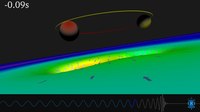
Symmetries and charges of general relativity at null boundaries
Sign Up to like & getrecommendations! Published in 2018 at "Journal of High Energy Physics"
DOI: 10.1007/jhep11(2018)125
Abstract: A bstractWe study general relativity at a null boundary using the covariant phase space formalism. We define a covariant phase space and compute the algebra of symmetries at the null boundary by considering the boundary-preserving… read more here.
Keywords: algebra; relativity null; general relativity; null boundaries ... See more keywords

Mass density and size estimates for spiral galaxies using general relativity
Sign Up to like & getrecommendations! Published in 2017 at "Astrophysics and Space Science"
DOI: 10.1007/s10509-017-3179-8
Abstract: Rotation curves of spiral galaxies reveal a physical phenomenon that has been seen to lack a satisfactory scientific explanation: velocities of stars far from the nucleus are high and approximately constant. In the context of… read more here.
Keywords: matter; general relativity; mass density; density ... See more keywords

On Representational Capacities, with an Application to General Relativity
Sign Up to like & getrecommendations! Published in 2020 at "Foundations of Physics"
DOI: 10.1007/s10701-018-0208-6
Abstract: Recent work on the hole argument in general relativity by Weatherall (Br J Philos Sci 69(2):329–350, 2018 ) has drawn attention to the neglected concept of (mathematical) models’ representational capacities. I argue for several theses… read more here.
Keywords: capacities application; general relativity; application general; representational capacities ... See more keywords

Structure of compact stars in R-squared Palatini gravity
Sign Up to like & getrecommendations! Published in 2017 at "General Relativity and Gravitation"
DOI: 10.1007/s10714-016-2182-7
Abstract: We analyse configurations of neutron stars in the so-called R-squared gravity in the Palatini formalism. Using a realistic equation of state we show that the mass–radius configurations are lighter than their counterparts in General Relativity.… read more here.
Keywords: compact stars; mass; equation state; general relativity ... See more keywords

Comparison of the DeWitt metric in general relativity with the fourth-rank constitutive tensors in electrodynamics and in elasticity theory
Sign Up to like & getrecommendations! Published in 2017 at "General Relativity and Gravitation"
DOI: 10.1007/s10714-017-2329-1
Abstract: We perform a short comparison between the local and linear constitutive tensor $$\chi ^{\lambda \nu \sigma \kappa }$$χλνσκ in four-dimensional electrodynamics, the elasticity tensor $$c^{ijkl}$$cijkl in three-dimensional elasticity theory, and the DeWitt metric $$G^{abcd}$$Gabcd in… read more here.
Keywords: dewitt metric; general relativity; electrodynamics elasticity; electrodynamics ... See more keywords

Superposition of fields of two rotating charged masses in general relativity and existence of equilibrium configurations
Sign Up to like & getrecommendations! Published in 2019 at "General Relativity and Gravitation"
DOI: 10.1007/s10714-019-2543-0
Abstract: It is known that two Reissner–Nordstrom black holes or two overextreme Reissner–Nordstrom sources cannot be in physical equilibrium. In the static case such equilibrium is possible only if one of the sources is a black… read more here.
Keywords: physical equilibrium; equilibrium; general relativity; two rotating ... See more keywords

Phantom singularities and their quantum fate: general relativity and beyond—a CANTATA COST action topic
Sign Up to like & getrecommendations! Published in 2019 at "General Relativity and Gravitation"
DOI: 10.1007/s10714-019-2618-y
Abstract: Cosmological observations allow the possibility that dark energy is caused by phantom fields. These fields typically lead to the occurrence of singularities in the late Universe. We review here the status of phantom singularities and… read more here.
Keywords: singularities quantum; phantom; cosmology; phantom singularities ... See more keywords

Phenomenologically viable gravitational theory based on a preferred foliation without extra modes
Sign Up to like & getrecommendations! Published in 2019 at "General Relativity and Gravitation"
DOI: 10.1007/s10714-019-2619-x
Abstract: We present a gravitational field theory that implements Hořava's proposal of foliation-preserving-diffeomorphisms symmetry and higher spatial curvature directly in the canonical formalism. Due to the higher spatial derivative the theory is potentially renormalizable. Since this… read more here.
Keywords: viable gravitational; theory; gravitational theory; general relativity ... See more keywords

Singularities of plane gravitational waves in Einstein’s general relativity
Sign Up to like & getrecommendations! Published in 2020 at "General Relativity and Gravitation"
DOI: 10.1007/s10714-020-02667-1
Abstract: Similar to the Schwarzschild coordinates for spherical black holes, the Baldwin, Jeffery and Rosen (BJR) coordinates for plane gravitational waves are often singular, and extensions beyond such singularities are necessary, before studying asymptotic properties of… read more here.
Keywords: left right; gravitational waves; plane gravitational; chi ... See more keywords

On average properties of inhomogeneous fluids in general relativity III: general fluid cosmologies
Sign Up to like & getrecommendations! Published in 2020 at "General Relativity and Gravitation"
DOI: 10.1007/s10714-020-02670-6
Abstract: We investigate effective equations governing the volume expansion of spatially averaged portions of inhomogeneous cosmologies in spacetimes filled with an arbitrary fluid. This work is a follow-up to previous studies focused on irrotational dust models… read more here.
Keywords: fluid; general relativity; average properties; properties inhomogeneous ... See more keywords

Asymptotic expansion of general relativity with Galilean covariance
Sign Up to like & getrecommendations! Published in 2020 at "General Relativity and Gravitation"
DOI: 10.1007/s10714-020-02738-3
Abstract: The Galilean gravitation derives from a scalar potential and a vector one. Poisson’s equation to determine the scalar potential has not the expected Galilean covariance. Moreover, there are three missing equations to determine the potential… read more here.
Keywords: expansion general; general relativity; galilean covariance; asymptotic expansion ... See more keywords